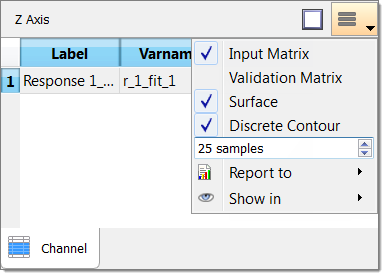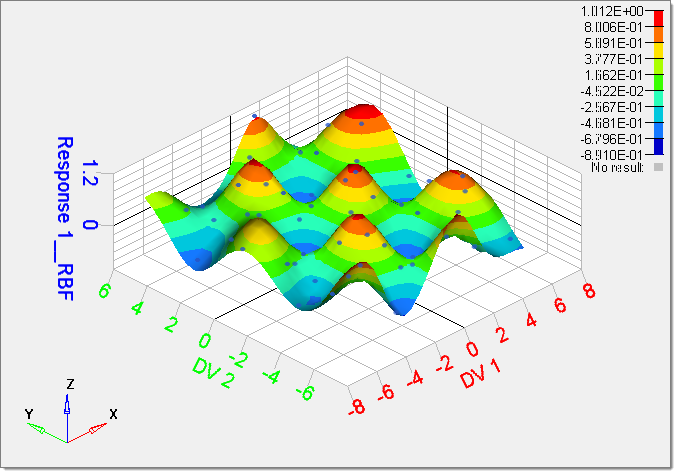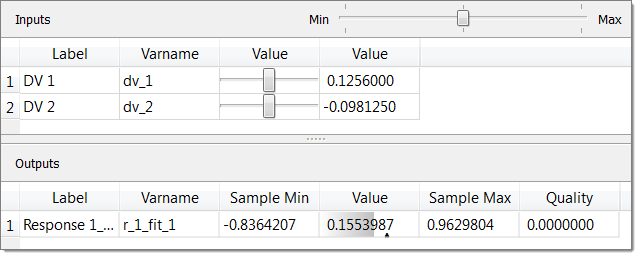In this tutorials, you will learn how to:
| • | Run a Design of Experiments (DOE) |
| • | Build a Fit to approximate the output responses |
| • | Export the Fit model to an Excel report |
| • | Use Excel to predict output response values |
Before starting this tutorial, you must add the HstAddinFit add-in to Excel. For instructions on to install the HstAddinFit add-in, refer to Fit Excel Plug-In.
| 2. | To start a new study, click File > New from the menu bar, or click  on the toolbar. on the toolbar. |
| 3. | In the HyperStudy – Add dialog, enter a study name, select a location for the study, and click OK. |
| 4. | Go to the Define models step. |
| 5. | Add an Internal Math model. |
| b. | In the HyperStudy - Add dialog, add one Internal Math model. |
| 6. | Go to the Define Input Variables step. |
| 7. | Click Add Input Variable. |
| 8. | In the HyperStudy - Add dialog, add two input variables. |
| 9. | Change the input variable's Lower Bounds, Initial, and Upper Bounds to the values indicated in the image below. |

| 10. | Go to the Specifications step. |
|
| 1. | In the work area, set the Mode to Nominal Run. |
| 3. | Go to the Evaluate step. |
| 4. | Click Evaluate Tasks. An approach/nom_1/ directory is created inside the study directory. |
| 5. | Go to the Define Output Responses step. |
|
| 1. | Click Add Output Response. |
| 2. | In the HyperStudy - Add dialog, add one output response. |
| 3. | In the Expression column, enter sin(dv_1)*cos(dv_2). |

| 4. | Click Evaluate Expressions. |
|
| 1. | In the Explorer, right-click and select Add Approach from the context menu. |
| 2. | In the HyperStudy - Add dialog, select Doe and click OK. |
| 3. | Go to the Specifications step. |
| 4. | In the work area, set the Mode to Hammersley. |
| 5. | In the Settings tab, Number of runs field, enter 50. |
| Note: | The large number of runs relative to the number of input variables is chosen to capture the highly non-linear nature of the output response function. This model is simple to evaluate, therefore the computational cost of the evaluation is not an important consideration in this example. |
| 7. | Go to the Evaluate step. |
|
| 1. | In the Explorer, right-click and select Add Approach from the context menu. |
| 2. | In the HyperStudy - Add dialog, select Fit and click OK. |
| 3. | Go to the Select matrices step. |
| 5. | In the HyperStudy - Add dialog, add one matrix. |
| b. | Set Matrix Source to Doe1 (doe_1). |

| 8. | Go to the Specifications step. |
| 9. | In the work area, set the Mode to Radial Basis Function. |
| 11. | Go to the Evaluate step. |
| 12. | Click Evaluate Tasks to evaluate the designs. |
| 13. | Go to the Post processing step. |
| 14. | Click the Trade-Off 3D tab to visualize the response surface as a function of two input variables. |
From the Channel tab, click  and adjust the plotting resolution of the display to include 25 samples. and adjust the plotting resolution of the display to include 25 samples.

| 15. | Visually examine the plotted response surface to inspect the quality of the approximation to the original sinusoidal function. |

| 16. | Click the Trade-Off 1D tab to interactively predict output response values as a function of the input variables. |
In the Inputs table, modify the values of each input variable by moving the slider in the first Value column, or by entering values in the second Value column. The predicted output response value in the Value column of the Outputs table is adjusted.
| Note: | The shaded spark lines in the Value cell indicate the relative value of the predicted output response with respect to the minimum and maximum of the sample. The marker at the bottom of the cell references the value of the predicted output response at the nominal values of the input variables. |

| 17. | Go to the Report step. |
|
| 1. | Select the HyperStudy Spreadsheet checkbox. |
| 2. | Click Create Report. An Excel report is generated and opened in Excel. |
| 3. | In the Excel report, click the Trade-Off 1D tab. |
| Note: | The structure and functionality of this tab is a reflection of the corresponding Trade-Off 1D tab within HyperStudy. You can adjust the input variable values on the right-hand side, and the predicted output response values are updated and displayed on the left-hand side. |

| 4. | To verify that the same values occur in the output response prediction columns for the same set of input variables, simultaneously adjust the values within HyperStudy and the Excel report. |
|
See Also:
HyperStudy Tutorials







